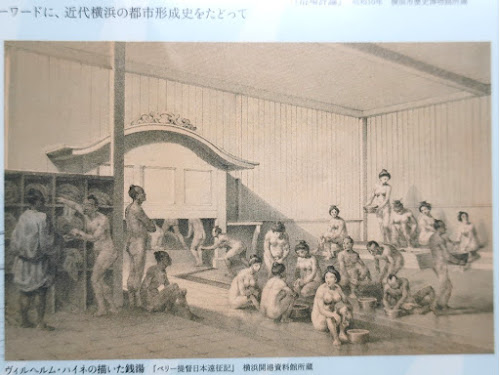From Niigata to Akita via Yamagata, inland journey
新潟から山形市経由で秋田へ、内陸の旅
Isabella had planned to go to Hokkaido by ship
from Niigata, and if she waited for a while, she could get on the ship.
However, she selected the inland journey. She was a whimsical lady.
当初予定していた北海道への船便がしばらくなかったので、イザベラは新潟を立ち、中条経由で荒川に沿って、内陸部に入る。物好きだ。
LETTER 18 KAMINOYAMA
She encountered spectators, who had never seen
a foreign lady, in every inn. She wrote her experience in Yonezawa where she
stayed at “daimiyo’s room”. There were several excellent inns for daimyo
lords in the post town in the Edo period, those are called “Honjin”. She stayed
at the superior room of the former Honjin. However, she wrote “there was no
privacy, for crowds climbed upon the roofs at the back, and sat there patiently
until night.”
 |
| Inside the “Honjin” in Kusatsu post town, Kusatsu Inn Headquarters 草津宿本陣 |
イザベラは旅を続けるが、行く先々宿屋で初めて外国の夫人を見る見物人に合う。米沢の旧本陣では、プライバシーがない、見物人が屋根に上って夜まで我慢強く待っている、と記している。
She went through the bustling hot spring
resort and wrote “At Akayu, a town of hot sulphur springs, ---, it was a one of the noisiest places I
have seen. In the most crowded part. ---, there are bathing shed, which were full of people of both sexes, splashing loudly,
---, several rheumatic people were lying on the mats, samisens were twanging and kotos screeching, and hubhub (loud
mixture of sound) was so unbearable ---“. “Samisen” and “koto” are stringed
instruments. And I would like to point out that “bathing of
both sexes” was not rare at that time. She
disliked such a noisy place, but Japanese people enjoyed so much.
She also wrote “The plain of Yonezawa, with the prosperous town of Yonezawa in the south, and the frequented watering-place of Akayu in the north, is a perfect garden of Eden”.
She also wrote “The plain of Yonezawa, with the prosperous town of Yonezawa in the south, and the frequented watering-place of Akayu in the north, is a perfect garden of Eden”.
 |
“Bathing of both sexes” in the Edo period, 江戸時代の混浴
|
彼女は、当時も賑わっていた赤湯を通り、今まで見た中で一番騒々しい場所だと言っている。温泉は混浴でしかも満員、水しぶきを飛ばす、三味線や琴をかき鳴らし、騒々しくて耐えられない、と記している。でも、日本人が本当に温泉を楽しんでいるのが分かる。
ところで、イザベラは米沢平野の農作物の豊かさと、湯量豊富な温泉があることに対して「パーフェクトなエデンの園だ」と書いている。有名な一節だ。
ところで、イザベラは米沢平野の農作物の豊かさと、湯量豊富な温泉があることに対して「パーフェクトなエデンの園だ」と書いている。有名な一節だ。
She escaped from Akayu and stayed at
Kaminoyama which is also a hot spring resort and a castle town, and the festival
was held there. It was the middle of July, so it would be a kind of Bon
Buddhist festival which welcome the ancestors’ spirits. She described “It is
keeping festival; there are lanterns and flags on every house, and crowds are
thronging the temple grounds” and “If it were within reach of foreigners, they
would find it a wholesome health resort,
with picturesque excursions in many directions.” She mentioned the effect
of the hot spring to cure rheumatism and how to take a bath too.
She was a bitter author, I think, however she
liked the scenery and the hot spring of Kaminoyama. She wrote about the joys of
the hot spring tour of Japanese; “This
is one of the great routes of Japanese and it is interesting to see
watering-places with their habits, amusements, and, civilization quite
complete, but borrowing nothing from Europe.” It was
indigenous to Japan. It is understandable that Japanese flocked to such a
good place. The policeman, who guarded her (she said “my frequent informants”),
told her that 600 people were staying at that time.
She stayed at a large inn which she
liked including owner’s family, but outside was full of revel because of
festival. She complained as usual; “This is a large yadoya, very full of
strangers, and the house-mistress --- has a truly exquisite hotel. --- the
hundreds of drumming blood-thirsty wretches outside.” I think that staying at inns and making noise were also
indigenous to Japan probably.
 |
Kaminoyama in winter、冬の上山市(山形県)
Reference:
Kaminoyama
castle museum 上山城郷土資料館
|
喧騒な赤湯を避けて、上山に来る。丁度お祭りだ。時期的には新暦のお盆になる。家々には提灯が下げられ旗が上げられており、人々がお寺の境内に押し寄せていると書いている。更に、外国人が知ったなら、絵のように美しい場所を散歩できるヘルス・リゾートだと思うだろう、と続ける。景色も温泉も良かったらしく、辛口のイザベラが褒めている。日本人が遊ぶのも当たり前だ。警護の警官によると上山には600人も泊まっていたという。
日本人の旅行ルートに一つで、ヨーロッパから来たものではない娯楽や文明がある、とも書いており、日本独自ということだ。そして、満員の大きな宿屋に泊る。女将さんたちにも満足していたが、外は祭りだしどんちゃん騒ぎだ。イザベラがいつも騒々しさに不快感を持つということは、宿に泊まって騒ぐのは、当時の日本独自の楽しみだろう。
LETTER 19 KANAYAMA, July 16.
The lifestyle of the big local city was
totally different from villages. She wrote “the plain of Yamagata, ---, is
populous and highly cultivated, ---, looks wealth and civilized.” The
population of Yamagata was 21,000 at that time.
She left Yamagata and went north. Fleas and
other insects bothered her in the rural area as usual.
山間部と都市、平野部で生活レベルが相当違っていたのだろう。山形の人口は21,000人であった。西洋的な建物もある山形から50km北にある新庄からは再び田舎道となり、昼も夜も蚤などの虫に悩まされながら、北に向かう。蚤やダニなどが激減したのは、戦後、米軍占領下で、DDTを散布してからだと、宮本常一氏は記している。
 |
Kanayama town where she wrote this
letter
タイトルにある金山町 *1
|
LETTER 21 KUBOTA(久保田=秋田), July 23
She arrived at Kubota (old name of
Akita) which is the big city on the Sea of Japan coast, and she praised it. She
wrote “Kubota is a very attractive and purely Japanese town of 36,000 people,
---, has an air of prosperity and comfort. --- Foreign influence is hardly at
all felt”. Akita prospered as a city of silk fabric then. She visited a
hospital, school and a factory of handloom silk-weavers.
イザベラは秋田を絶賛する。褒めるのとけなすのが両極端である。また、海外の影響は見られないと記している。秋田は絹で栄えていたらしい。病院、学校に続き、絹織物工場を訪問する。
 |
| Main street in the Meiji period、明治時代の秋田市大町通り http://dl.ndl.go.jp/info:ndljp/pid/762376/234、日本写真帖(1912) |
LETTER 23 KUBOTA, July 24.
She referred to Ito who attended her as an
interpreter. She appreciated him. She wrote about his pleasure, “He
sends most of his wages to his mother,--- and seems to spend the remainder (of
his wages) on sweetmeats, tobacco, and the luxury of frequent shampooing” and “he never touches
sake”. The origin of “shampoo” was written “in the sense massage ( as part of a Turkish bath process)”, so I guess it was
not only massaging but also contained rubbing the body and so on. Moreover
she wrote “He despises the intellects of women, but flirts in a town-bred
fashion with tea-house girls.” That must be fun for him. He “Tsurukichi Ito”
succeeded as an interpreter later, we can find his biography on Wikipedia Japanese
version today.
通訳として同行している伊藤の様子を述べている。伊藤を基本的には評価しているが、伊藤の楽しみとして、母親に送金した残りは、甘味、たばこ、と贅沢であるマッサージに使うという。shampooの語源は”in the sense massage ( as part of a Turkish bath process)”と書かれており湯を使って洗う感じがある。いろいろなサービス・楽しみがあったのではないか。伊藤は、酒を手にしない。また、都会風の遊び方で茶屋の娘と戯れる、とも書かれている。20代の伊藤だから、これは楽しみであったろう。
 |
| Tea-house girl in Nikko Yumoto by Isabela、日光湯元の茶屋の娘 |
Previous
post (From Nikko to Niigata in deep mountains 日光から新潟への山中の旅):
Next
post (Stay in Akita and inland journey again 秋田での滞在と再び内陸の旅):
Travel
of Isabella L. Bird in 1878, part 6 イザベラバードが見た明治初期の日本(6)
There are 12 articles about Isabella's travel in Japan. The first page:
イザベラバードの旅は全12ページの記事です。最初の記事は上記のURLです。



Comments
Post a Comment